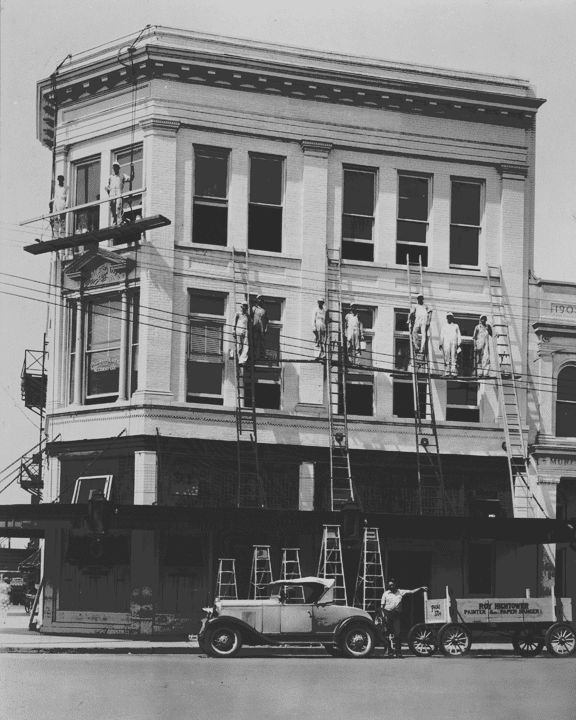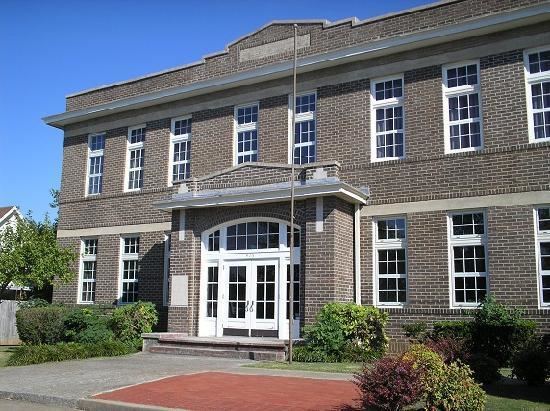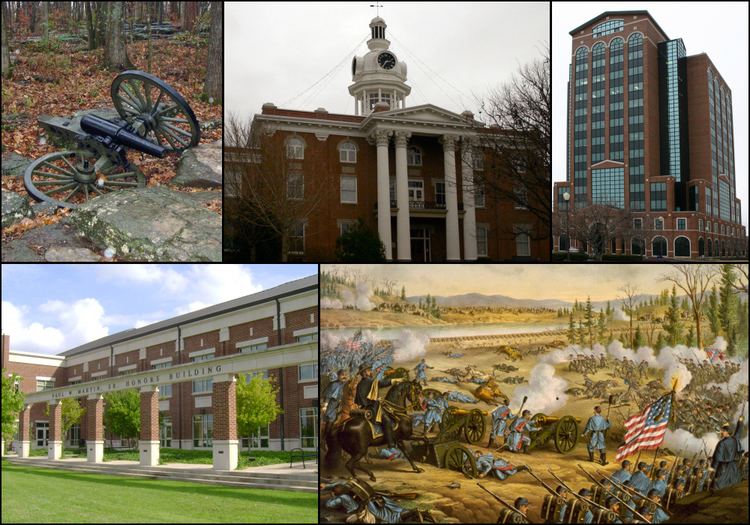Country United States State Tennessee | Population 117,044 (2013) Area 39.2 sq mi Mayor Shane McFarland (R) | |
 | ||
Points of interest Stones River National Battlefield, Oaklands, Johnny "Red" Floyd Stadium | ||
Unemployment rate 5.0% (Feb 2015) | ||
Map of Murfreesboro, Tennessee
Murfreesboro is a city in, and the county seat of, Rutherford County, Tennessee, United States. The population was 108,755 according to the 2010 census, up from 68,816 residents certified in 2000. In 2016, census estimates showed a population of 131,947. The city is the center of population of Tennessee, located 34 miles (55 km) southeast of downtown Nashville in the Nashville metropolitan area of Middle Tennessee. It is Tennessee's fastest growing major city and one of the fastest growing cities in the country. Murfreesboro is also home to Middle Tennessee State University, the largest undergraduate university in the state of Tennessee, with 22,729 total students as of fall 2014.
Contents
- Map of Murfreesboro Tennessee
- Restaurants in murfreesboro tn 6158677717 best restaurant in murfreesboro
- Murfreesboro checkpoint police caught lying on camera
- History
- Civil War
- Post Civil War
- Government
- Geography
- Transportation
- Public transportation
- Demographics
- Education
- Parks
- Music
- Arts
- Museums
- Shopping
- Media
- Mosque controversy
- Points of interest
- Top employers
- Murfreesboro tn organic foods the greenery on the square
- References

In 2006, Murfreesboro was ranked by Money as the 84th best place to live in the United States, out of 745 cities with a population over 50,000.

Restaurants in murfreesboro tn 6158677717 best restaurant in murfreesboro
Murfreesboro checkpoint police caught lying on camera
History
In 1811, the Tennessee State Legislature established a county seat for Rutherford County. The town was first named "Cannonsburgh" in honor of Newton Cannon, then Rutherford County's member of the state legislature, but it was soon renamed "Murfreesboro" for Revolutionary War hero Colonel Hardy Murfree. Author Mary Noailles Murfree was his great-granddaughter.

As Tennessee settlement expanded to the west, the location of the state capital in Knoxville became inconvenient for most newcomers. In 1818, Murfreesboro was designated as the capital of Tennessee. Eight years later, however, it was itself replaced by Nashville.
Civil War
On December 31, 1862, the Battle of Stones River, also called the Battle of Murfreesboro, was fought near the city between the Union Army of the Cumberland and the Confederate Army of Tennessee. This was a major engagement of the American Civil War, and between December 31 and January 2, 1863, the rival armies suffered a combined total of 23,515 casualties. It was the bloodiest battle of the war by percentage of casualties.
Following the Confederate retreat after the drawn Battle of Perryville in central Kentucky, the Confederate army moved through East Tennessee and then turned northwest to defend Murfreesboro. General Braxton Bragg's veteran cavalry successfully harassed Union General William Rosecrans' troop movements, capturing and destroying many of his supply trains. However, they could not completely prevent supplies and reinforcements from reaching Rosecrans. Despite the large number of casualties, the battle was inconclusive. Nevertheless, it is usually considered a Union victory, since afterwards General Bragg retreated 36 miles (58 km) south to Tullahoma. Even so, the Union army did not move against Bragg until a full six months later in June 1863. The battle was significant since it did provide the Union army with a base to push the eventual drive further south, which allowed the later advances against Chattanooga and Atlanta. These eventually allowed the Union to divide the Eastern and Western theaters, followed by Sherman's March to the Sea. The Stones River National Battlefield is now a national historical site.
General Rosecrans' move to the south depended on a secure source of provisions, and Murfreesboro was chosen to become his supply depot. Soon after the battle, Brigadier General James St. Clair Morton, Chief Engineer of the Army of the Cumberland, was ordered to build Fortress Rosecrans, some 2 miles (3.2 km) northwest of the town. The fortifications covered about 225 acres (0.91 km2) and were the largest built during the war. Fortress Rosecrans consisted of eight lunettes, four redoubts and connecting fortifications. The Nashville and Chattanooga Railroad and the West Fork of the Stones River both passed through the fortress, while two roads provided additional transportation.
The fort's interior was a huge logistical resource center, including sawmills, warehouses, quartermaster maintenance depots, ammunition magazines, and living quarters for the 2,000 men who handled the operations and defended the post. The fortress was completed in June 1863, and only then did Rosecrans dare to move south. The fortress was never attacked, in part because the Union troops held the town of Murfreesboro hostage by training their artillery on the courthouse. Major portions of the earthworks still exist and have been incorporated into the battlefield site.
Post-Civil War
Murfreesboro had begun as a mainly agricultural community, but by 1853 the area was home to several colleges and academies, gaining the nickname the "Athens of Tennessee". Despite the wartime trauma, the town's growth had begun to recover by the early 1900s, in contrast to other areas of the devastated South.
In 1911, the state legislature created Middle Tennessee State Normal School, a two-year institute to train teachers. It would soon merge with the Tennessee College for Women. In 1925 the Normal School was expanded to a four-year college. In 1965 it became Middle Tennessee State University. MTSU now has the largest undergraduate enrollment in the state, including many international students.
World War II resulted in Murfreesboro diversifying into industry, manufacturing, and education. Growth has been steady since that time, creating a stable economy.
Murfreesboro has enjoyed substantial residential and commercial growth, with its population increasing 123.9% between 1990 and 2010, from 44,922 to 100,575. The city has been a destination for many immigrants leaving areas affected by warfare; since 1990 numerous Somalis and Kurds from Iraq have settled here. The city has also become more cosmopolitan by attracting more numerous international students to the university.
Government
The city council has six members, all elected at-large for four-year terms, on staggered schedules with elections every two years. The mayor is elected at large. City council members have responsibilities for various city departments.
Geography
Murfreesboro is located at 35°50′46″N 86°23′31″W.
According to the United States Census Bureau, the city has a total area of 39.2 square miles (102 km2). 39.0 square miles (101 km2) of it is land and 0.2 square miles (0.52 km2) of it (0.54%) is water. However, as of 2013 the city reports its total area as 55.94 square miles (144.9 km2).
Murfreesboro is the geographic center of the state of Tennessee. A stone monument marks the official site on Old Lascassas Pike, about 0.5 miles (0.80 km) north of MTSU.
The West Fork of the Stones River flows through Murfreesboro. A walking trail, the Greenway, parallels the river for several miles. A smaller waterway, Lytle Creek, flows through downtown including historic "Cannonsburgh Village". Parts of the 19-mile (31 km) long creek suffer from pollution due to the urban environment and its use as a storm-water runoff.
Murfreesboro is home to a number of natural and man-made lakes plus several small wetlands including Todd's Lake and the Murfree Spring wetland area.
Murfreesboro has been in the path of destructive tornados several times. On April 10, 2009, an EF4 tornado struck the fringes of Murfreesboro. As a result, two people were killed and 41 others injured. 117 homes were totally destroyed, and 292 had major damage. The tornado is estimated to have caused over $40 million in damage.
Transportation
Murfreesboro is served by Nashville International Airport (IATA code BNA), Smyrna Airport (MQY) and Murfreesboro Municipal Airport (MBT). The city also benefits from several highways running through the city, including Interstates 24 and 840; U.S. Routes 41, 70S, and 231; and State Routes 1, 2, 10, 96, 99, and 268. Industry also has access to North-South rail service with the rail line from Nashville to Chattanooga.
Public transportation
Since April 2007, the City of Murfreesboro has established a new transportation system with nine small buses, each capable of holding sixteen people and including two spaces for wheelchairs. The system is called "Rover"; the buses are bright green with "Rover" and a cartoon dog painted on the side. Buses operate in six major corridors: Memorial Boulevard, NW Broad Street, Old Fort Parkway, South Church Street, Mercury Boulevard and Highland Avenue.
A one-way fare is US$1.00 for adults, US$0.50 for children 6–16 and seniors 65 and over, and free for children under 6. The system operates Monday to Friday, 6:00 a.m. to 6:00 p.m.
Demographics
As of the 2010 census, there were 108,755 people residing in the city. The racial makeup of the city was 75.62% White, 15.18% Black / African American, 0.35% Native American, 3.36% Asian, 0.04% Pacific Islander, 2.79% from other races, and 2.65% from two or more races. Hispanic or Latino of any race were 5.93% of the population.
In the 2000 Census, There were 26,511 households out of which 30.7% had children under the age of 18 living with them, 43.8% were married couples living together, 11.9% had a female householder with no husband present, and 40.6% were non-families. 28.3% of all households were made up of individuals and 7.0% had someone living alone who was 65 years of age or older. The average household size was 2.42 and the average family size was 3.02.
In the city, the population was spread out with 22.7% under the age of 18, 20.5% from 18 to 24, 30.8% from 25 to 44, 17.3% from 45 to 64, and 8.8% who were 65 years of age or older. The median age was 29 years. For every 100 females there were 98.7 males. For every 100 females age 18 and over, there were 97.2 males.
The median income for a household in the city was $39,705, and the median income for a family was $52,654. Males had a median income of $36,078 versus $26,531 for females. The per capita income for the city was $20,219. About 8.2% of families and 14.1% of the population were below the poverty line, including 12.0% of those under the age of 18 and 11.1% of those 65 and older.
Special census estimates in 2005 indicated 81,393 residents, and in 2006 the U.S. Census Bureau's American Community Survey estimated a population of 92,559, with 35,842 households and 20,979 families in the city. Murfreesboro's 2008 special census reported that the population had reached 100,575, while preliminary information from the 2010 U.S. Census indicates a population of 108,755.
Education
Education within the city is overseen by Murfreesboro City Schools (MCS). MCS focuses on prekindergarten through sixth grade learning. The city has 12 schools serving 7,200 students between grades pre-K through 6th. A 13th school, named Overall Creek Elementary was scheduled to be completed by 2014. More than 68% of licensed employees have a master's degree or higher.
High schools are overseen by Rutherford County Schools, which has 42 schools and a student population of nearly 40,000.
The Japanese Supplementary School in Middle Tennessee (JSMT, 中部テネシー日本語補習校 Chūbu Teneshī Nihongo Hoshūkō), a weekend Japanese education program, holds its classes at Peck Hall of the Middle Tennessee State University, while its school offices are in Jefferson Square.
Parks
Cannonsburgh Village is a reproduction of what a working pioneer village would have looked like from the period of the 1830s to the 1930s. Visitors can view the grist mill, school house, doctor's office, Leeman House, Caboose, Wedding Chapel, and other points of interest. It is also home to the World's Largest Cedar Bucket.
Old Fort Park is a 50-acre (200,000 m2) park which includes baseball fields, tennis courts, children's playground, an 18-hole championship golf course, picnic shelters and bike trail.
Barfield Crescent Park is a 430-acre (1,700,000 m2) facility with eight baseball fields, 7 miles (11 km) of biking/running trails, an 18-hole championship disc golf course, and ten picnic shelters.
Murfreesboro Greenway System is a system of greenways with 12 miles (19 km) of paved paths and 11 trail heads. In 2013, the city council approved a controversial 25-year "master plan" to extend the system by adding 173 miles worth of new greenways, bikeways and blueways at an estimated cost of $104.8 million.
Music
Murfreesboro hosts several music-oriented events annually, such as the Main Street Jazzfest presented by MTSU's School of Music and the Main Street Association each May. For over 30 years, Uncle Dave Macon Days has celebrated the musical tradition of Uncle Dave Macon. This annual July event includes national competitions for old-time music and dancing.
Because of MTSU's large music program, the city has fostered a number of bands and songwriters, including: The Tony Danza Tapdance Extravaganza, A Plea for Purging, Self, Fluid Ounces, The Katies, Count Bass D, Destroy Destroy Destroy and The Features.
Arts
The Murfreesboro Center for the Arts, close to the Square, entertains with a variety of exhibits, theatre arts, concerts, dances, and magic shows. Murfreesboro Little Theatre has provided the community with popular and alternative forms of theatre arts since 1962.
Murfreesboro's International FolkFest began in 1982 and is held annually during the second week in June. Groups from countries spanning the globe participate in the festival, performing traditional songs and dances while attired in regional apparel.
The MTSU Student Film Festival showcases student-submitted films annually during the second week in April.
Other organizations include Youth Empowerment through Arts and Humanities and the Murfreesboro Youth Orchestra.
Museums
The Discovery Center at Murfree Spring is a nature center and interactive museum focusing on children and families. The facility includes 20 acres (8 ha) of wetlands with a variety of animals.
Bradley Academy Museum contains collectibles and exhibits of the first school in Rutherford County. This school was later renovated to become the only African American school in Murfreesboro, which closed in 1955.
The Stones River National Battlefield is a national park which memorializes the Battle of Stones River, which took place during the American Civil War during December 31, 1862, to January 3, 1863. The grounds include a museum, a national cemetery, monuments, and the remains of a large earthen fortification called Fortress Rosecrans.
Oaklands Historic House Museum is a 19th-century mansion which became involved in the Civil War. It was occupied as a residence until the 1950s, after which it was purchased by the City of Murfreesboro and renovated into a museum by the Oaklands Association.
Shopping
There are two main malls located within the city limits. Stones River Mall is a traditional enclosed mall, featuring stores and restaurants such as Forever 21, Aéropostale, Journey's, Hot Topic, Agaci, Dillard's, Buckle, Books-A-Million, Olive Garden, and T.G.I. Friday's.
The Avenue Murfreesboro is an outdoor lifestyle center with such shops as American Eagle, Hollister, Best Buy, Belk, Petco, Dick's Sporting Goods, Express, Mimi's Cafe, Romano's Macaroni Grill, and LongHorn Steakhouse.
The Historic Downtown Murfreesboro district also offers a wide variety of shopping and dining experiences that encircle the pre-Civil War Courthouse.
Media
Murfreesboro is serviced by the following media outlets:
Newspapers:
Radio:
TV:
Mosque controversy
Beginning in 2010, the Islamic Center of Murfreesboro faced protests related to its plan to build a new 12,000-square-foot (1,100 m2) mosque. The county planning council had approved the project, but opposition grew in the aftermath, affected by this being a year of elections. Signs on the building site were vandalized, with the first saying "not welcome" sprayed across it and the second being cut in two. Construction equipment was also torched by arsonists.
In August 2011, a Rutherford County judge upheld his previous decision allowing the mosque to be built, noting the US constitutional right to religious freedom and the ICM's observance of needed process. The Center has a permanent membership of around 250 families and a few hundred students from the university. The case ultimately attracted national media attention as an issue of religious freedom.
Points of interest
Murfreesboro is the home of a Consolidated Mail Outpatient Pharmacy (CMOP). It is part of an initiative by the Department of Veterans Affairs to provide mail order prescriptions to veterans using computerization at strategic locations throughout the United States. It is located on the campus of the Alvin C. York Veterans Hospital.
The City Center building (also known as the Swanson Building) is the tallest building in Murfreesboro. Located in the downtown area it was built by Joseph Swanson in 1989. It has 15 floors, including a large penthouse, and stands 211 feet (64 m) tall. As a commercial building its tenants include Bank of America and is the headquarters for the National Healthcare Corporation (NHC).
Top employers
According to Murfreesboro's 2014 Comprehensive Annual Financial Report, the top employers in Rutherford County are:
